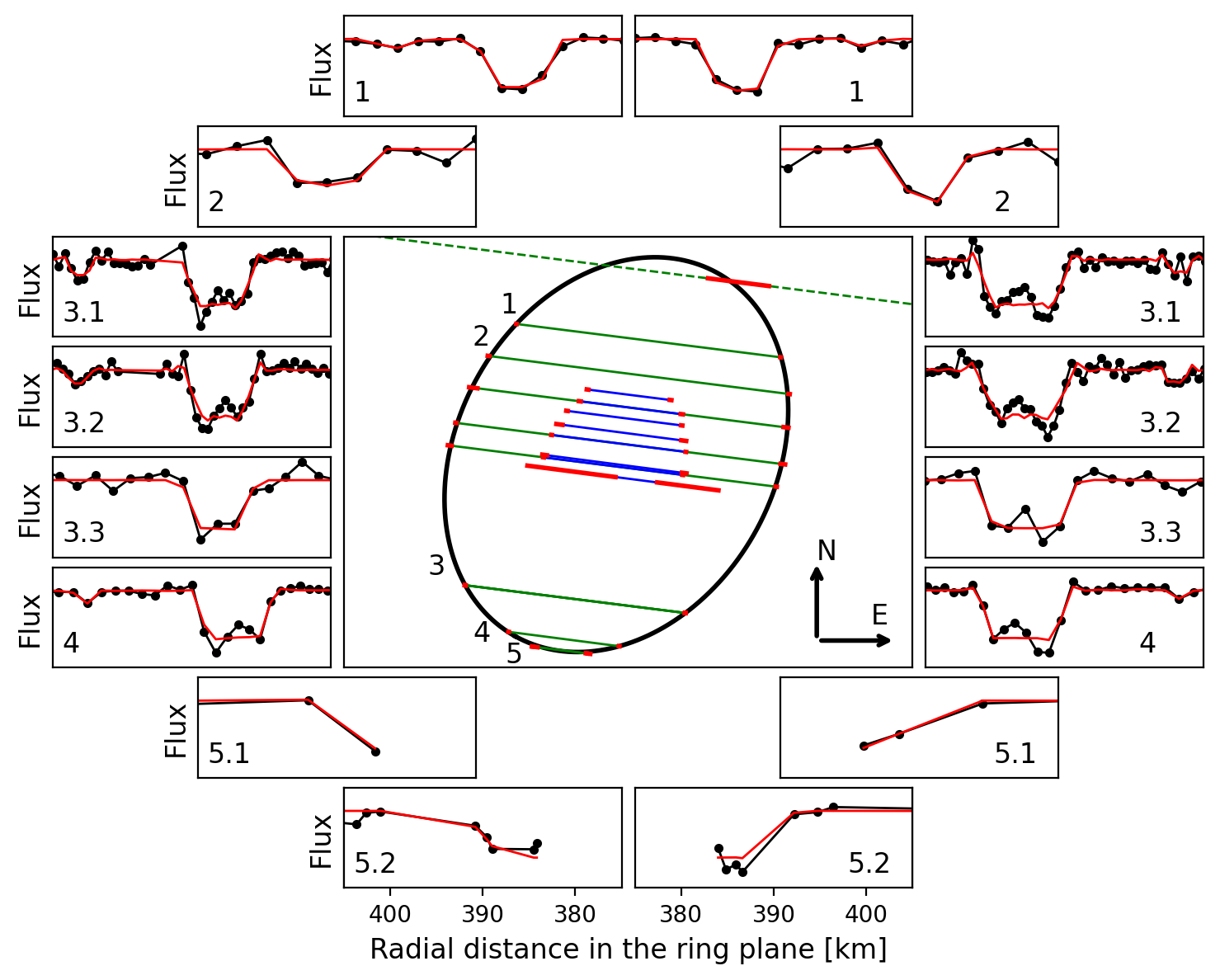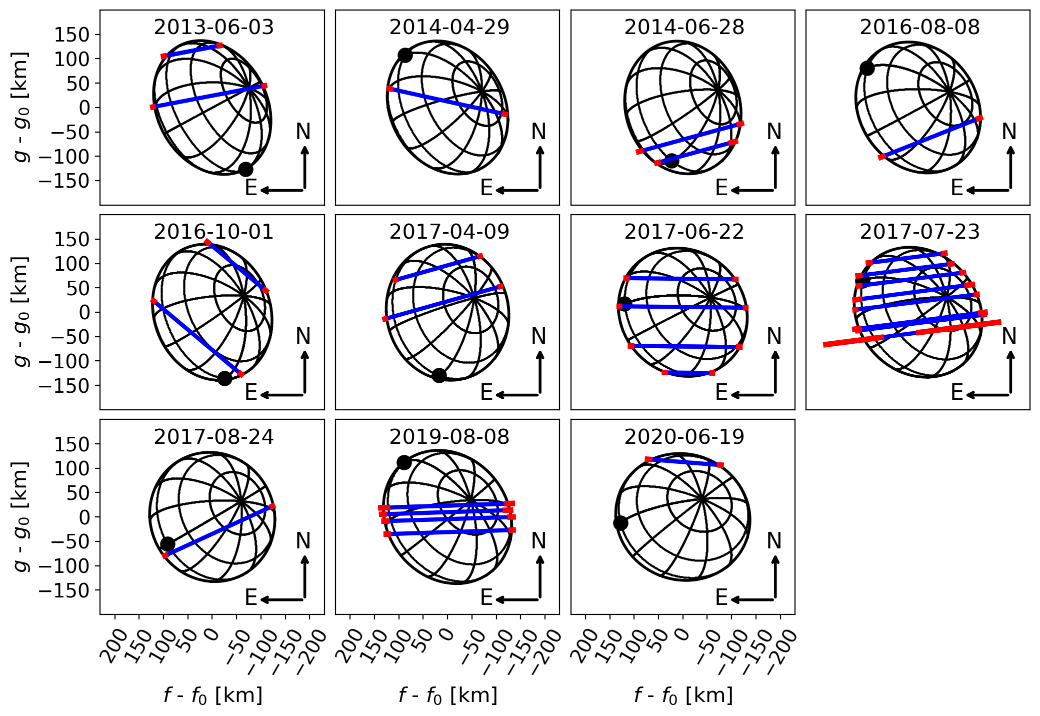The Centaur (10199) Chariklo and its ring system through stellar occultations.
- 1LESIA, Observatoire de Paris, Université PSL, CNRS, Sorbonne Université, Univ. Paris Diderot, Sorbonne Paris Cité, 5 place Jules Janssen, 92195 Meudon, France
- 2Laboratório Interinstitucional de e-Astronomia - LIneA, Rua Gal. José Cristino 77, Rio de Janeiro, RJ 20921-400, Brazil
- 3Observatório Nacional/MCTI, R. General José Cristino 77, CEP 20921-400 Rio de Janeiro - RJ, Brazil
- 4Federal University of Technology - Paraná (UTFPR / DAFIS), Rua Sete de Setembro, 3165, CEP 80230-901, Curitiba, PR, Brazil
- 5Institut Polytechnique des Sciences Avancées IPSA, 63 boulevard de Brandebourg, 94200 Ivry-sur-Seine, France
- 6Institut de Mécanique Céleste et de Calcul des Éphémérides, IMCCE, Observatoire de Paris, PSL Research University, CNRS,Sorbonne Universités, UPMC Univ Paris 06, Univ. Lille, 77, Av. Denfert-Rochereau, 75014 Paris, France
- 7UNESP - São Paulo State University, Grupo de Dinâmica Orbital e Planetologia, CEP 12516-410, Guaratinguetá, SP, Brazil
- *A full list of authors appears at the end of the abstract
The Centaur (10199) Chariklo is a small body moving in an elliptical orbit, between Saturn and Uranus, with heliocentric distances ranging 13.1 and 18.9 au. It is the largest object known in this orbital region, and since its discovery in 1997 (Ticha et al. 1997), many studies tried to characterise this object. From the literature, different observational techniques give an equivalent surface radius ranging between 109 and 151 km (Sekiguchi et al., 2012; Lellouch et al., 2017). Additionally, a ring system was detected by Braga-Ribas et al. (2014) using stellar occultation data sets acquired in 2013. Between 2013 and 2016, other stellar occultations brought more detailed information on this system (Bérard et al., 2017; Leiva et al., 2017).
A stellar occultation occurs when a solar system object passes in front of a star for an observer on Earth. Using this technique it is possible to determine sizes and shapes at kilometre precision and to obtain other physical parameters, such as its albedo, the presence of an atmosphere, rings, jets, or topographic features (Braga-Ribas et al., 2013, 2019; Dias-Oliveira et al., 2015, 2017; Benedetti-Rossi et al., 2019; Ortiz et al., 2017; Leiva et al., 2017; Bérard et al., 2017; Santos-Sanz et al., 2021).
After the release of the Gaia DR2 catalogue (Gaia collaboration et al., 2018), the stars' positions are known with uncertainties below one milliarcsecond (mas). Moreover, after successful stellar occultations observations, Chariklo ephemeris was updated, now it has uncertainties below five mas ($\sim$50 km at Chariklo's distance). Accurate star's positions and updated ephemeris resulted in successful observational campaigns in Namibia (22/06/2017), South America (23/07/2017) and La Réunion (08/08/2019). These were the first Chariklo occultations with more than three chords across the main body. These events increased our knowledge about Chariklo's shape, and this information can be used to constrain the dynamic of its rings. Six other events were observed between 2017 and 2020, however with fewer detections on the main body.
In this work, we will present the obtained results, such as the global shape of Chariklo's rings system, including its pole determination, the ring width variation, structures within the rings (see Figure 1), the width of the gap between C1R and C2R and limits for the ring eccentricity and particle's sizes. Also, the 3D shape of Chariklo was obtained from eleven stellar occultations observed between 2013 and 2020 (see Figure 2). The parameters obtained in this work should be useful for constraining dynamical models of Chariklo and its rings and provide new insights into the formation and evolution of this system.

Figure 1: Results of the 2017-07-23 event. The central plot displays the occulting chords projected in the sky-plane for the main body (in blue), C1R (in green), and their uncertainties (red segments). The black line is the best-fitting ellipse to the C1R point. The side panels display the normalised radial ring profiles, projected in the ring-plane, numbered as follows: VLT at Cerro Paranal (1), Tolar Grande (2), La Silla (3), Observat\'orio Pico dos Dias (4) and Cerro Tololo (5). The observations on La Silla were made using the Danish telescope dual experiment in the Visual (3.1) and Red bands (3.2) and a 1-meter telescope (3.3). The observations on Cerro Tololo were grazing over C1R and they were made using the SARA (5.1) and PROMPT (5.2). We call attention to the unambiguous detection of W-shaped structures within the C1R.

Figure 2: Ellipsoidal model that best fits the 11 stellar occultations observed between 2013-06-23 and 2020-06-19. Each panel corresponds to an occultation event identified by the time stamp in the upper part of each one. The blue lines stand for the observed chords with their uncertainties in red. The black dot indicates the intersection between the equator and the prime meridian, which is used as the reference to define the rotation angle.
References:
Benedetti-Rossi G. et al., 2019, The Astronomical Journal, 158, 159.
Bérard D. et al., 2017 Astronomical Journal, 154, 144.
Braga-Ribas F. et al., 2014, Nature, 508, 72.
Braga-Ribas F. et al., 2019, Journal of Physics: Conference Series, 1365, 012024.
Dias-Oliveira A. et al., 2015, The Astronomical Journal, 154, 22.
Dias-Oliveira A. et al., 2017, Astronomical Journal, 811, 53.
Gaia Collaboration et a., 2018, Astronomy and Astrophysics, 616, A1.
Leiva R. et al., 2017 Astronomical Journal, 154, 159.
Lellouch et al., 2017, Astronomy and Astrophysics, 608, A45.
Ortiz J. L. et al., 2017, Nature, 550, 219.
Santos-Sanz et al., 2021, MNRAS, 501 (4), 6062.
Sekiguchi et al., 2012, Asteroids, Comets, Meteors, 1667, 6477.
Acknowledgements:
This work was carried out within the “Lucky Star" umbrella that agglomerates the efforts of the Paris, Granada and Rio teams, which is funded by the European Research Council under the European Community’s H2020 (ERC Grant Agreement No. 669416). This research made use of \textsc{sora}, a python package for stellar occultations reduction and analysis, developed with the support of ERC Lucky Star and LIneA/Brazil, within the collaboration Rio-Paris-Granada teams. This work has made use of data from the European Space Agency (ESA) mission Gaia (\url{https://www.cosmos.esa.int/gaia}), processed by the Gaia Data Processing and Analysis Consortium (DPAC, https://www.cosmos.esa.int/web/gaia/dpac/consortium). The following authors acknowledge the respective CNPq grants: BEM 150612/2020-6; FB-R 314772/2020-0; RV-M 304544/2017-f5, 401903/2016-8; JIBC 308150/2016-3 and 305917/2019-6; MA 427700/2018-3, 310683/2017-3, 473002/2013-2. GBR acknowledges CAPES-FAPERJ/PAPDRJ grant E26/203.173/2016 and CAPES-PRINT/UNESP grant 88887.571156/2020-00, MA FAPERJ grant E-26/111.488/2013 and ARGJr FAPESP grant 2018/11239-8. J.L.O., P.S-S., R.D., and N.M. acknowledge financial support from the State Agency for Research of the Spanish MCIU through the ``Center of Excellence Severo Ochoa'' award to the Instituto de Astrofísica de Andalucía (SEV-2017-0709). P.S-S. acknowledges financial support by the Spanish grant AYA-RTI2018-098657-J-I00 ``LEO-SBNAF'' (MCIU/AEI/FEDER, UE).
D. Bérard; R. Leiva; J. L. Ortiz; R. Vieira-Martins; G. Benedetti-Rossi; P. Santos-Sanz; J. I. B. Camargo; R. Duffard; M. Assafin; R. Boufleur; F. L. Rommel; F. Colas ; M. Kretlow; W. Beisker; R. Sfair; C. Snodgrass; N. Morales; E. Fernández-Valenzuela
How to cite: Morgado, B., Sicardy, B., Braga-Ribas, F., Desmars, J., and Gomes-Júnior, A. and the Luckystar team: The Centaur (10199) Chariklo and its ring system through stellar occultations., European Planetary Science Congress 2021, online, 13–24 Sep 2021, EPSC2021-435, https://doi.org/10.5194/epsc2021-435, 2021.

